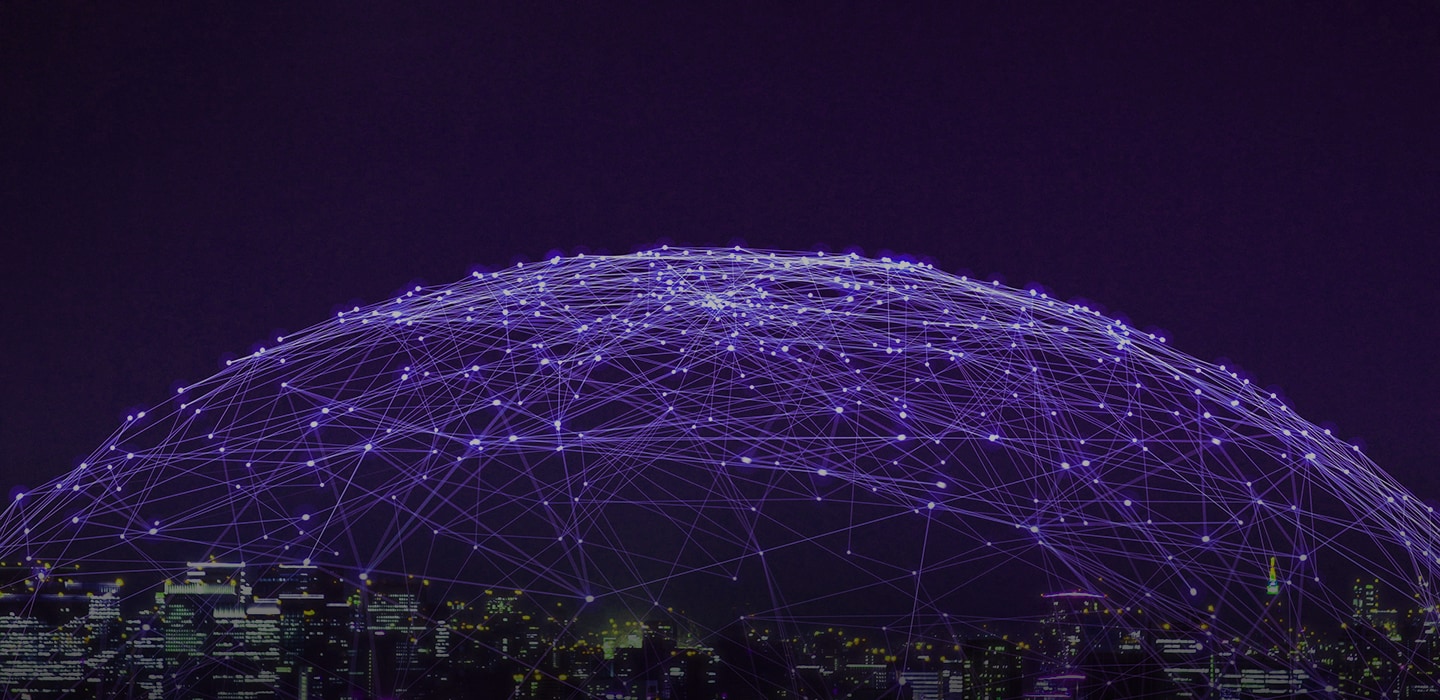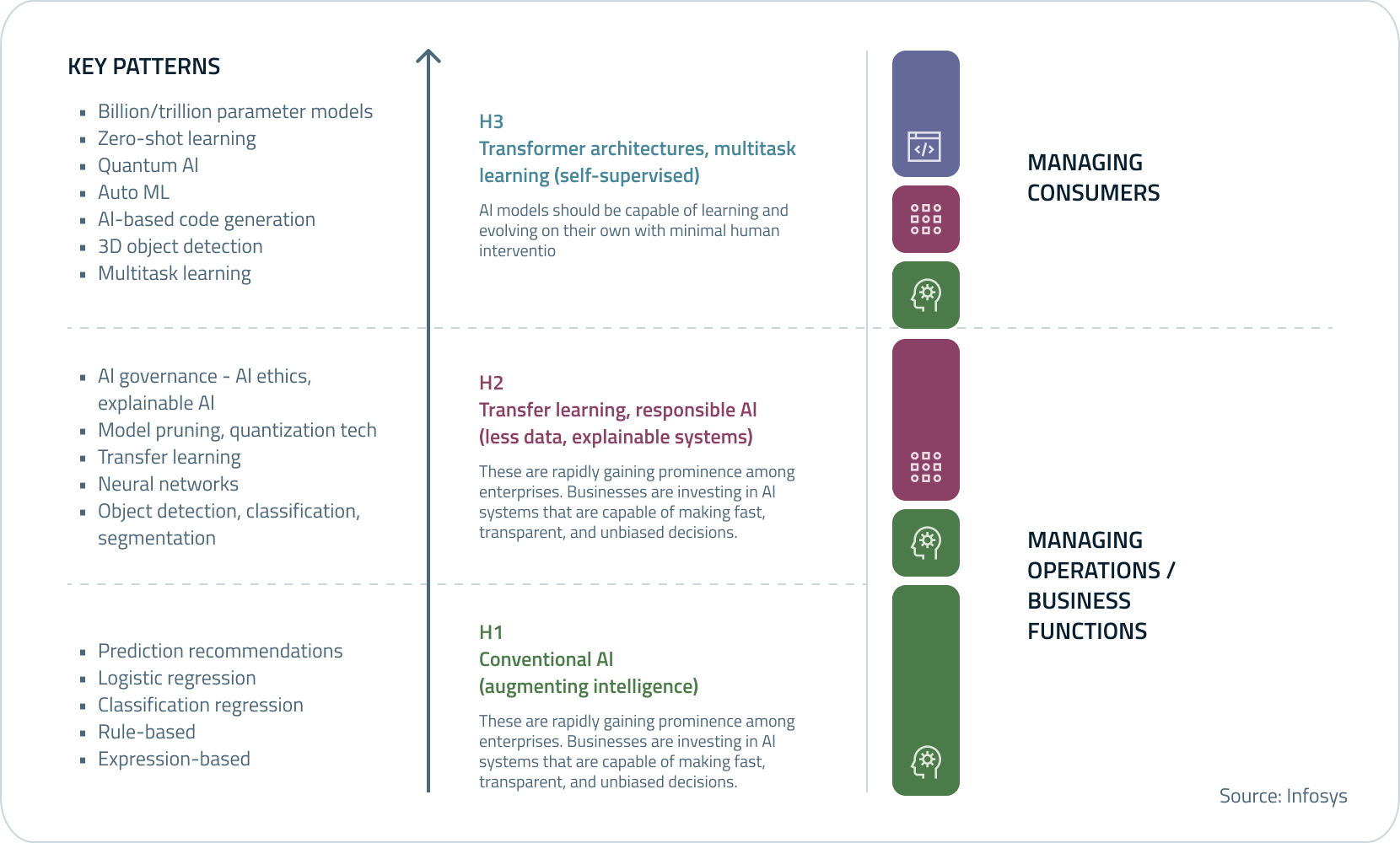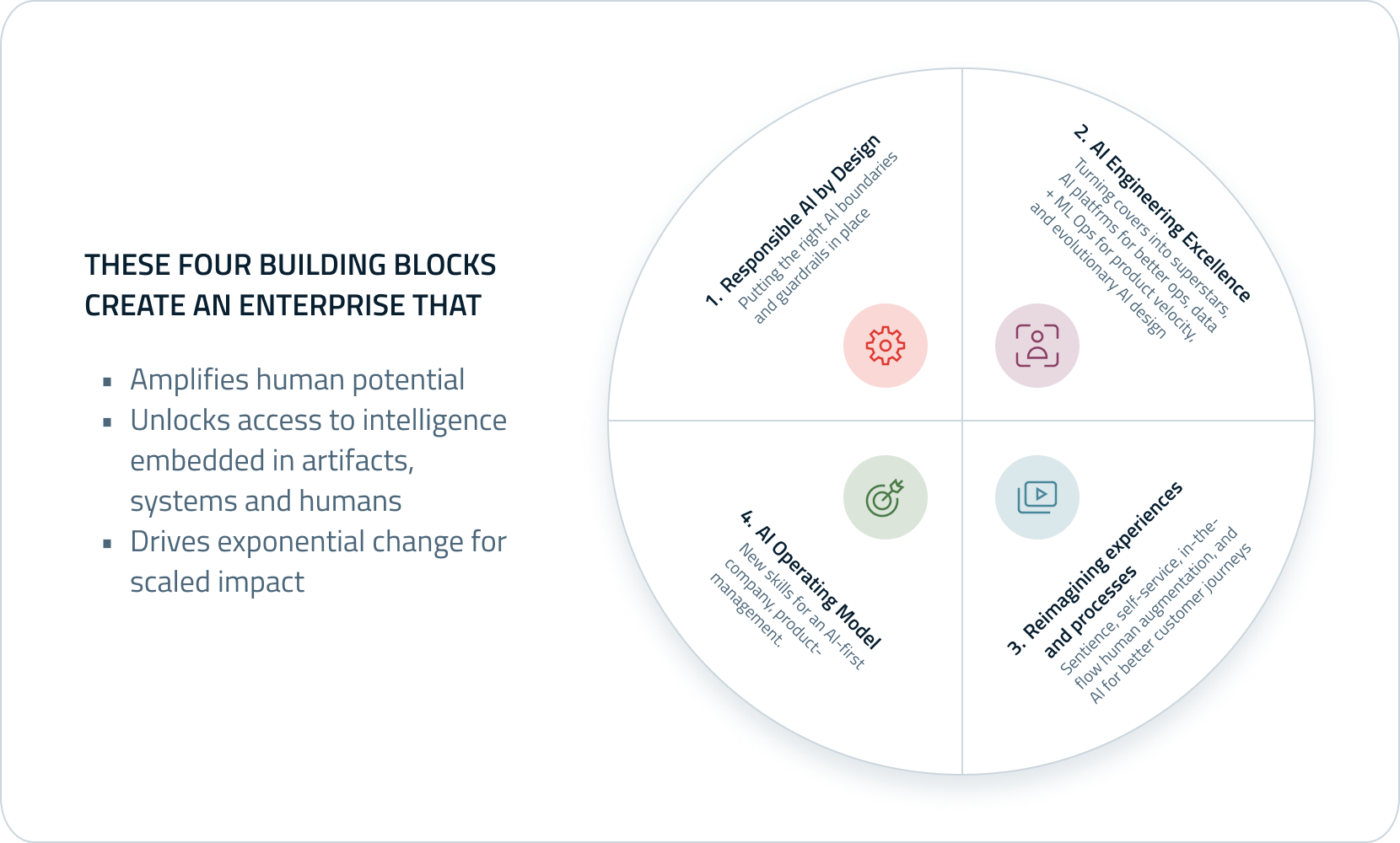

The excitement around generative AI has created an investment frenzy and organizations are making big bets on it. However, while they pump in the money, businesses are approaching AI with the same mindset that they have deployed for tech adoption earlier. Unfortunately, that approach will not work for AI. Read this article to find out what you need to do to truly unleash the potential of AI.
Lemonade, the built-for AI1 insurance platform, managed to do what no other traditional insurer had achieved. They issued new policies in 90 seconds and processed claims in 3 minutes2. They’ve taken intelligent automation to the next level and removed almost all non-core human intervention. This is just one example of how AI-first companies will disrupt operating models across industries. Ash Fontana, famed AI investor and author of “The AI-First Company – How to Compete and Win with Artificial Intelligence,3” highlights the case of AI-first companies mostly being trillion-dollar companies and still seeking to dominate more industries than ever before.
Organizations know the transformative potential of AI and want to make it an inherent part of their business and growth strategies. And they are making big bets on it. JPMorgan Chase, for instance, has committed to drive $1 billion in business value through AI investments by the end of this year5. Gartner found that 55% of organizations that have previously deployed artificial intelligence always consider AI for every new use case they are evaluating6.

Thinking AI-First
Design-led engineering has made a significant impact in shaping the direction of many a product and services. AI now seeks to claim its place as an integral part of organizational strategy. AI technology and model evolution are happening at a breathtaking pace, with new models and techniques emerging weekly. An AI-first business prioritizes using artificial intelligence in its operations and strategy to become an autonomous enterprise.
The evolution to this state typically involves moving through a journey of three horizons;
Horizon 1: Conventional AI
During this wave, companies are primarily focused on automating processes and using AI to improve efficiency and productivity. Think of rule-based systems and supervised learning to perform tasks like data entry, image recognition, and the AI system being fast, transparent, and unbiased. These include use cases like intelligent document processing, fraud detection, loan approvals, etc.
Horizon 2: Predictable & Responsible AI
This wave features companies beginning to explore the potential of AI to create new business models and revenue streams. This involves using AI to make predictions and recommendations and to personalize customer experiences. Think Netflix or Uber and how they have leveraged AI to change business models and customer experience.
Horizon 3: Self-supervised AI
In this wave, companies are at the forefront of AI innovation and are exploring the potential of self-supervised learning and other advanced AI techniques. Facebook AI has worked in self-supervised AI, particularly in developing unsupervised learning algorithms.

The move from H1-H3 (horizons) for companies is challenging, and overcoming these requires thinking along the lines of four building blocks to model an AI-first organization truly.
The Four Building Blocks Of An AI-First Organization
- Responsible AI by design
Although AI adoption is exploding, the domains of security, ethics, and governance are scrambling to keep up. Hackers are already breaking the guardrails of tools such as ChatGPT to misuse their potential. Facial recognition algorithms have been found to exhibit racial bias, with higher error rates for people of color. This has raised concerns about using facial recognition technology in law enforcement and other applications and the potential for discrimination and harm. Similarly, algorithms used in hiring have been found to exhibit bias against certain groups, such as women and minorities. This can perpetuate existing inequities in the workplace and limit opportunities for specific individuals. Companies aiming to be AI-first must create a robust framework to ensure AI’s responsible and ethical use. - AI Engineering Excellence
Companies must focus on AI engineering excellence to drive the velocity of AI products. This includes leveraging productivity-enhancing tools such as OpenAI’s Codex, GitHub’s Copilot, and ChatGPT, which can empower hard-pressed coders, to platform engineering, which equips developers with self-service capabilities through an internal platform. They also need to consider the impact of large language models (LLMs) and generative models on data and machine learning operations (MLOps). And finally, the AI systems should be trustworthy and built to evolve. This means developing self-supervised AI models incorporating reinforcement learning with human feedback (RLHF) across knowledge, reasoning, and actuation.
And finally, the GPT models are dated and can only provide information till the point in time when they were last trained. GPT4, for instance, was last trained in September 2021, and its responses are limited to information before that time frame.

- Reimagining experiences and processes
Most existing processes aren’t suitable for an AI-first enterprise. In the connected, generative AI era, firms must move from vertical or horizontal entities to providers of a complete customer journey. While we reimagine and re-engineer processes for an AI era, it’s essential to acknowledge the importance of a human-in-the-loop (HIL) to comply with regulations and to ensure that trust, transparency, and explainability are not compromised. - The AI Operating Model
Our Digital Radar 2023 research found that it is not necessarily the introduction of technology that makes the difference but the way in which the firm is organized to take advantage of it. AI-first businesses need a new way of looking at the organization, with teams organized around dedicated customer journeys or value chains. Companies will also need to look at building the skills needed to enable an AI-first spirit. Employees now need to pivot to problem-solving with a human touch transcending over traditional processes, geographies, or functions, focusing on empathy and integrity.
Loved what you read?
Get practical thought leadership articles on AI and Automation delivered to your inbox


Loved what you read?
Get practical thought leadership articles on AI and Automation delivered to your inbox
The Future With AI-First Organizations
It’s increasingly becoming evident that AI will move from simply being a tool to manage operations and business functions to now managing consumers in large, connected ecosystems. While AI democratization has begun, only those with the right digital and cloud foundation can leapfrog into this era. At the same time, workplace transformation and AI-driven labor market shift are on the horizon to ensure AI is harnessed to amplify human potential and not displace it. Riding the AI wave is not going to be easy. It will shake the foundations of how businesses operate. Yet, if done right, it will be incredibly rewarding.
Disclaimer Any opinions, findings, and conclusions or recommendations expressed in this material are those of the author(s) and do not necessarily reflect the views of the respective institutions or funding agencies
- https://www.pymnts.com/earnings/2023/lemonade-ceo-says-insurance-platform-built-for-ai-since-day-one/
- https://www.lemonade.com/
- https://www.amazon.com/AI-First-Company-Compete-Artificial-Intelligence-ebook/dp/B08MVSH7XZ
- https://www.forbes.com/advisor/in/business/ai-statistics/
- https://www.jpmorganchase.com/content/dam/jpmc/jpmorgan-chase-and-co/investor-relations/documents/events/2023/jpmc-investor-day-2023/JPM-Investor-Day-2023-Final-Full-Transcript.pdf
- https://www.gartner.com/en/newsroom/press-releases/2023-07-27-gartner-survey-finds-55-of-organizations-that-have-deployed-ai-take-an-ai-first-strategy-with-new-use-cases



